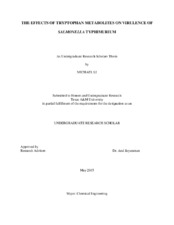| dc.description.abstract | Salmonella is a foodborne pathogen that invades the human gastrointestinal (GI) tract from the intestinal lumen by targeting intestinal epithelial cells (IECs). It is able to breach the protective IEC barrier with the aid of needle-like complexes encoded by a cluster of genes known as the Salmonella pathogenicity island 1 (SPI1). The influence that molecules in the GI tract have on pathogenicity and virulence is not yet fully understood because of the complexity and abundance of metabolites present in the GI microenvironment. One source of metabolites is the amino acid tryptophan, which is transformed into indole and other indole-like metabolites by the microbiota in the GI tract. Roles for many of the gut metabolites are still unknown. Previous research in the Jayaraman laboratory has shown that indole, a tryptophan metabolite, decreases the virulence of Salmonella. In this project, we studied the effects of tryptophan derivatives which are present in the GI tract – indole-acetic acid, tryptamine, indole-pyruvic acid, and hydroxyindole – on the virulence of Salmonella. The motility of the pathogen in response to the different tryptophan derivatives was determined using the swimming motility assay (SMA). The expression of SPI1 genes was measured using the β-galactosidase reporter assay as a measure of virulence. The results of the SMA show that the tryptophan derivatives tested do not affect the motility of Salmonella significantly, whereas indole decreases motility by 40%. The effect of these metabolites on the expression of SPI1 genes, hilA and invF, was observed to be much less compared with that of indole. We therefore conclude that not all tryptophan metabolites present in the GI tract decrease the virulence of Salmonella Typhimurium to the same extent. Further research needs to be done to determine the roles of these tryptophan derivatives as well as several other molecules present in the GI tract microenvironment. | en |


